Q&A – Ask Neil: December 29, 2022
(Please read these instructions carefully.)
Before you post your question, please look at recent issues to see if someone else has already asked it. You might find your answer there.
November 24, 2022 Q&A part one
November 24, 2022 Q&A part two
How to submit your question…
• Click the link provided below to post your question. After you submit your question, a new window will pop up giving you the address to which you can e-mail a photo to accompany your question. Clear, medium-resolution photos. (Try to avoid low-res thumbnail photos, please, in case I have to zoom in to see things.)
• Click here to post your question.
• Please only post your question one time.
• One question per reader, please.
• Please use this only for posting questions – not for standard emails.
• Watch for your answer in the following week’s e-gardens.
• I choose those of greatest general interest. For example, plant IDs seldom make the cut.
• I must have your first name or initials.
• I must have your city or county. (Texas is a very large state.)
QUESTION 1
DO SURFACE ROOTS MEAN MY OAK TREES ARE STRESSED?
Question: Over the summer I’ve noticed roots of my red oak and live oak trees are coming to the surface. These trees are more than 25 years old. Should I try to cover the roots with soil? Does this mean the trees are stressed? Susan T., Sachse, Dallas Co.
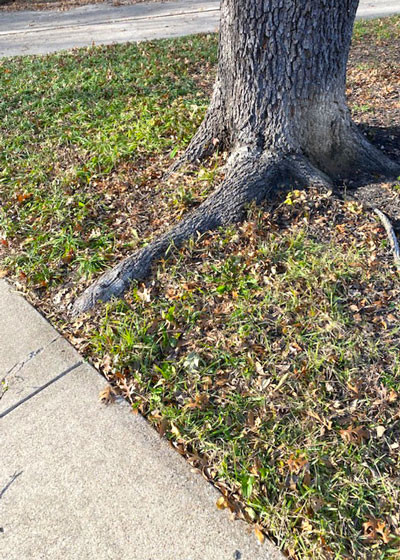
Answer: This is absolutely normal. 90 percent of any tree’s roots are in the top 12 inches of the soil line. As the roots grow larger they swell up and out of the soil. Do not try to conceal them by covering them with topsoil. They will merely grow out of it as well. As I mentioned in another story I had already written for this issue, excessive shade is going to prevent grass from growing beneath the trees. You need a shade-tolerant groundcover to replace the turf. However, you have a bigger concern. The one root is cracking the concrete. You’re going to have to take immediate action, probably to remove that one root and perhaps to have a root barrier installed by a certified arborist. If that’s just a sidewalk you may want to take it out entirely and move it farther from the tree, perhaps replacing it with interlocking concrete pavers.
QUESTION 2
WHY IS BARK SEPARATING FROM TRUNK OF MY OAK?
Question: I have a 12-year-old oak tree with a piece of bark that is separating from the trunk. Is this caused by a disease, or is it normal aging? Edward S., Tarrant Co.
Answer: If it’s a live oak (evergreen leaves), it’s probably the issue called “radial shake” that was caused by the extreme cold of February 2021. If the top growth has been normal and full for the past 22 months your tree will be fine. But without a photo I can’t give you an accurate assessment.
QUESTION 3
IS BASHAM’S PARTY PINK A GOOD CRAPE MYRTLE?
Question: I have read about the crape myrtles you recommend, but I have never seen you mention Basham’s Party Pink. We have planted some and I’m wondering if it was a good choice. Robert V., Tarrant Co.
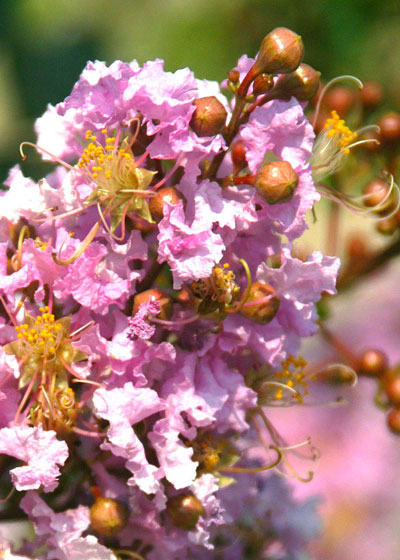
Answer: It is a beautiful large variety that grows to 35 ft. tall and taller. In his book The Lagerstroemia Handbook/Checklist (1978) Dr. Don Egoff of the United States National Arboretum reported that Basham’s Party Pink was a chance seedling found by B.M. Basham in Conroe, Texas, in 1963 and introduced by renowned Texas plantman Lynn Lowrey in 1965, Dr. Egolf reported it to be resistant to powdery mildew. My concerns with it have been (1) it is not readily available and (2) whether it is winter-hardy as far north as DFW. Since you’re saying you have several, I’m assuming they survived the “Great Winter” of February 2021 (and hopefully also survived last week’s cold– we’ll find out next spring). If so, thumbs up!
QUESTION 4
ARE VARIETIES OF SALVIA GREGGII EVERGREEN?
Question: I have found the red autumn sage to be dependably evergreen. Would you say the other colors are, too? We want small evergreen, wildlife-friendly shrubs. Linda V., Euless.
Answer: I garden in rural Collin County. Our temperatures may be slightly colder than what you experience in Euless. I have not found any of the autumn sages to be what I would call “evergreen.” That doesn’t particularly matter, however, because you want to trim them back by half in late January or early February anyway to promote the flush of spring growth and blooms.
QUESTION 5
IS THERE A REPLACEMENT FOR VARIEGATED PITTOSPORUM?
Question: Can you recommend a replacement for dwarf variegated pittosporum? I like the contrast of its light leaves against dark green shrubs, but they are too problematic in the winter. Kathryn F., University Park.
Answer: There aren’t a lot of good variegated shrubs, and when you said “dwarf” variegated pittosporum, that tightened the knot even more. I think my best recommendation would be the dwarf abelias. I’m going to let you Google Abelia ‘Kaleidoscope’ and ‘Twist of Lime.’ While I was looking online I found several others that I haven’t grown, including ‘Silver Anniversary’ and ‘Confetti.’ Try a few of one of them to see if you like the results. You’ll even get flowers to go with the variegation.
QUESTION 6
WHAT DO I DO WITH BALL MOSS IN CRAPE MYRTLES?
Question: I have some crape myrtles that have been overtaken by ball moss. They have few leaves and few blooms. What is the best way to rejuvenate them? Robert K., Van Alstyne.
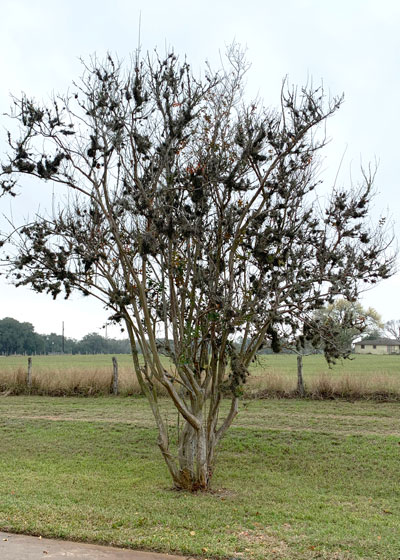
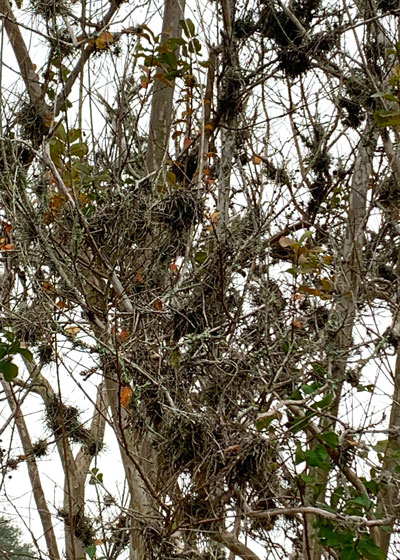
Answer: I’ve been asked this before from gardeners in South Texas, but never by anyone as far north as you are. I’m going to go out on a limb and guess that your plants came from a grower in South Texas. That’s probably how the ball moss got its start. It’s sister to Spanish moss. Both are in the genus Tillandsia. Both are epiphytes, meaning that they use their “host” plants only for support, getting no water or nutrients from them.
Here is what the Texas A&M Forest Service has to say about ball moss and its control.
If I had plants that looked like the one in your photo I believe I would cut them back to the ground and retrain them anew. Carefully remove and destroy all of the old growth so there is none of the ball moss left on site.
Here is how we recommend the retraining be done on this page from the website of The Crape Myrtle Trails of McKinney. (I wrote this information for that page.) Scroll to the bottom where I wrote about dealing with crape myrtles that had previously been topped.
QUESTION 7
WHAT IS CAUSE OF SAP ON OUR CHINESE PISTACHIO?
Question: Our Chinese pistachio tree has started weeping sap from several 1-1/4-in. branches. I do not see any borer holes. Could this be bacterial canker? We planted this tree 4 years ago and had its main trunk wrapped for 2 years. Nancy W., Tolar.
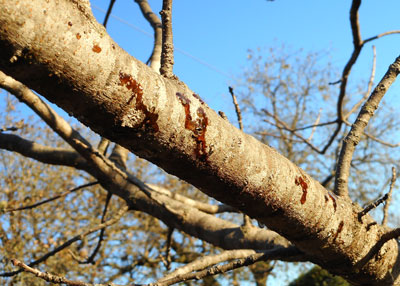
Answer: I don’t know. I’ve spent 20 minutes looking through university plant pathology websites (Texas A&M, Clemson, Penn State, Arizona State, Oklahoma State and one I couldn’t figure out). I found no mention of any trunk or branch disease. I did see reference to pistachio borers on a couple of websites.
I would suggest taking a very shallow slice of the bark with a single-edged razor blade or a sharp pocket knife. See if there is any evidence of a hole beneath the sap (that would suggest a borer) – or perhaps an elongated crack (that could be sunscald or some disease). Save the slice and sap in a zip-lock plastic sandwich bag in case you want to send it to the Texas A&M Plant Disease Diagnostic Laboratory in College Station for culturing. Take a photo of the fresh bark beneath the cut to show what the wood looks like. That more than anything will tell you what is going on with your tree. I may hear from one of my certified arborist friends who monitors my answers here with additional information. (Hope I do.) Maybe we both can learn from your question.
QUESTION 8
WHAT SHOULD I DO WITH A CRAPE MYRTLE THAT WAS TOPPED?
Question: I have a very large crape myrtle that was recently topped by the power company. It had a beautiful shape before, but now I’m heartbroken. Should I attempt to reshape it or allow it to fill in naturally? Charity H., Denison.
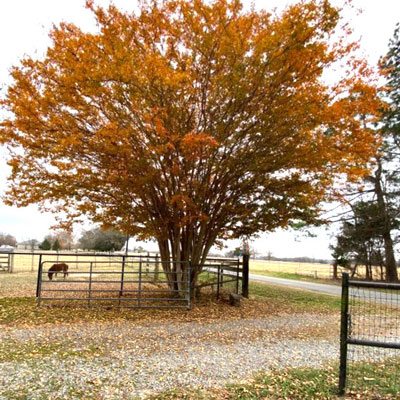
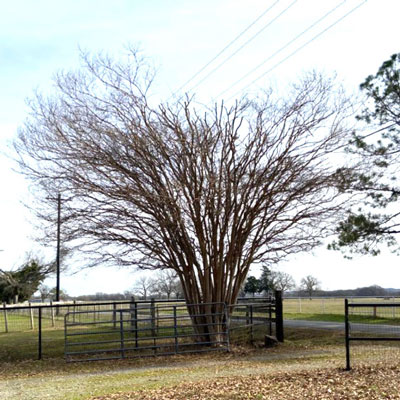
Answer: I’m on a rural electric coop power circuit. One of our trees was constantly causing problems until we figured a work-around that involved my paying to have our service line buried. Our guys had to come out in some awful weather because our trees kept causing problems for our neighborhood, so I do understand their plight. However, I’m also a crape myrtle lover. There is no pruning you can do that will restore its shape. You’re better off letting it regrow, but I fear that now that the company knows it’s there, that they will come back. Truly the only really good solution would be to move the plant. As large as it is, that would require a tree spade, but it could be done. Talk to a landscape contractor in Sherman or Denison.
QUESTION 9
MY APPLE TREE HAS BLACK FUNGUS ON ITS TRUNK AND ONE BRANCH. IS THERE A TREATMENT OPTION?
Question: I have an apple tree that was planted in 2017. It has a black fungus developing along the main trunk and on one of the branches. There is also damage at the bottom of the trunk. What should I do? Jean J., Lewisville.

Answer: I’m very concerned about your tree. It looks like it may have been vigorous in some recent time, but that black tissue is decay setting into the interior wood of the limb and moving down into the trunk. I also see cracking in the lower part of the trunk, so there may have been decay there from the outset. In any event, the top branch with the two black forks as well as the trunk down to the next two limbs (and perhaps farther) all appear to have died. It looks like you have left a short nub on the trunk where you pruned it at the top. That may be where the decay all began. It obviously has not healed properly. I see another stub on the camera side of the trunk near the bottom of the photo. That appears to be a much more recent (fresher) pruning cut. You never want to leave stubs like that. They will never heal properly. I guess my suggestion would be to trim the trunk back to remove the two black branches and the piece of the trunk that is attached to them. Cut back flush with the next pair of reddish limbs. If the main trunk shows decay there, go down to the next (and final) branch and prune above it. By that point, however, you would have destroyed the tree’s shape. You’d be better off buying a new tree.
QUESTION 10
CAN WE REUSE POTTING SOIL FROM LAST YEAR’S CONTAINER GARDEN?
Question: We planted 90 flowers in pots last year and used a high-quality potting soil of a major brand. Can we re-use that soil next year, or should we start with fresh soil? Michael B., Fort Worth.
Answer: I grow most of my annual color in large pots. In my case I prefer to start with fresh potting soil each year. I use the prior year’s soil in my vegetable garden and in large pots in which I grow foliage plants. They are more forgiving of soil that is starting to break down. (Organic matter in good potting soils decays with age.) At a bare minimum I would amend the old soil with 3 parts of old soil, 1 part each of sphagnum peat moss and finely ground pine bark mulch. I might mix a bit more (15 percent by volume) perlite as I turned the soil.
QUESTION 11
WHAT CAUSED DEEP GROOVES IN MY SWEET POTATOES?
Question: We tried growing sweet potatoes from commercially grown slips. They look awful! They were grown in raised beds and watered daily using an above-ground irrigation system. Any idea what caused the deep grooves? Liz H., Johnson Co.
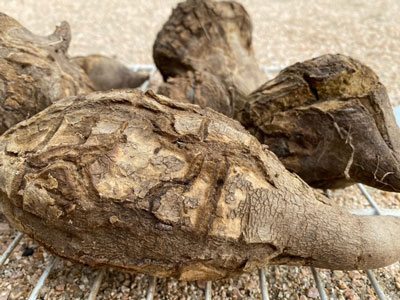
Answer: I did not. I spent half an hour trying to find an answer from various southern university websites but I kept coming up blank. So I did what I do when I’m backed into a corner of the vegetable garden. I called for a rescue from my friend, Dr. Jerry Parsons (Prof. Emeritus Texas A&M and retired from the Extension Service). Jerry and I have known each other for 50 years. He’s the one who has developed our state flower the bluebonnet in so many different colors, and he was one of three on the team who began the Texas Superstar® plant program. He still does his weekend radio program in San Antonio and maintains his Plant Answers website. But first, Jerry was a vegetable specialist.
As usual, Jerry bailed me out where even the Internet let me down. (Take notice, Internet!) Here was his answer to your question. Liz, you and I both will note that he writes “sweetpotato” as one word, symbolic of the fact that it’s not a true potato.
Said Dr. Parsons… (Thanks, Jerry)
Neil,
Those are growth cracks caused by age (I have some of those on my body as well!) of the sweetpotatoes coupled with too much watering. I do not see any weevil damage – that is a good thing. Folks growing sweetpotatoes in Texas, especially South and Central Texas, have such a long growing season that the roots (sweetpotatoes) swell and crack. To prevent this from happening, growers should check the vines/roots (at the point they were planted) several months before the first expected freeze. In Johnson County that starts in August or September. I imagine those cracked roots are very “stringy” and tough. She waited too long to harvest.
